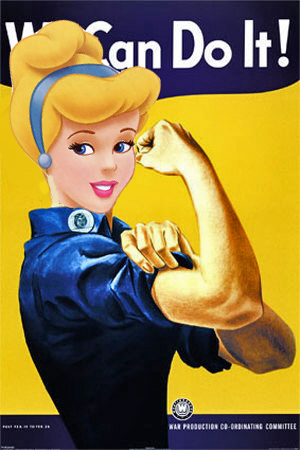On Princesses and Feminism

I’m a feminist.
Some of the more sharp-eyed readers here may have already noticed it. Definitely anyone who knows me. But I never announced it plainly and publicly, until now. So there it is. I’m a feminist. I do not hate men (I, in fact, love the one I live with and quite a few others), nor do I automatically support everything every woman does (some women do some crazy things). But I do believe that women should have equal opportunities. Particularly, I think my daughter should have equal opportunities.
Which is a problem. Because my daughter, you see, is a tiny little girl who loves pink, princesses, and ballet. When I asked her what she wanted to be when she grows up, she said: “I want to be a mommy like you”. After I was done melting, I told her she can be a mommy and something else, like I am a mommy and a scientist. She thought long and hard (she was three at the time), and said: “OK. I want to be a mommy and a princess.”
For a good long while, I was trying to fight this girliness. I thought that if she’ll be a tomboy, like I was, she would be more of a feminist. She would stand up for herself more, she would think of herself as more capable. I was never a tomboy like Caroline Paul, but growing up in a village in the middle of the desert necessitates some hardiness, even for girls. Nevertheless, I liked to read and play with Barbies (although, admittedly, I would mostly take them apart to see how they worked), and I ended up a feminist. But my girl’s girliness is a level up. We are talking about a person who, at one year of age, when I brought her to the daycare for the first time, made a beeline to the home-corner, commenced nursing the babies there, and refused to leave (which made me realise that in the pandemonium of having my second baby when my first was not two yet, I neglected to purchase any dolls for the lovely lady-to-be. Or any girly toys. She had her brother’s hand-me-downs).
I was particularly worried when I read two articles talking about this. In the first, published in 2014, the experimenters randomly assigned girls (age 4-7 years) into one of three conditions: the first group played with a Mrs. Potato Head, the second group played with a “Fashion Barbie”, and the third played with a “Doctor Barbie”. After 5 minutes of play, the experimenter showed the girls some pictures of work places (such as a restaurant, a hospital, and so on), and asked whether the girls could work there when they grow up, and whether a boy could work there when he grew up. Girls who played with either Barbie were more likely to say that they can’t work at more of the places. In other words, playing with a Barbie for 5 minutes reduced girls’ career options for themselves. There are several issues with this study, however, including the rather small sample size (37 girls total). And I haven’t seen a replication, which is suspicious because that’s quite the effect. Still, it breaks your heart to think that 5 minutes of playing with a Barbie could do that much damage.
The second study was published in 2016, and followed preschoolers (boys and girls) for a year. The authors wanted to assess the impact of children’s engagement with Disney Princesses on their gender-stereotypical behaviours, their body image, and their prosocial behaviour (such as helping and sharing). The experimenters asked the children which toys they preferred, and they also asked the children’s parents and teachers about the child’s gender-stereotypical behaviours and preference for boys’ and girls’ toys. They also asked parents about the child’s engagement with Disney Princesses, body image, and prosocial behaviour as well. After a year, the parents filled a questionnaire asking again about the child’s toys preference, engagement with Disney Princesses, gender-stereotypical behaviours, body image, and prosocial behaviour and also about how often does the parent talk to the child about the media the child was watching. What they found was that engagement with Disney Princesses was associated with more gender-stereotypical behaviours for girls, even after controlling for the girls’ previous gender-stereotypical behaviours. In other words, the more the girl watched, played, and identified with Disney Princesses, the more likely she was to exhibit girly behaviours. Now, as the researchers point out, playing house isn’t in itself problematic, but when girls exhibit more gender-stereotypical behaviours, they are less likely to explore and take risks which may be fundamental to their development.
I stopped fighting my daughter’s liking of everything princess a long time ago. Mostly because, at least for this particular child, the more we fight with her on something, the more likely she is to resist. Which bodes well for us in the future, especially when we’ll go into the teenage years (hey, Internet, how are we doing on that sarcasm font?). But also because I read this post and, while it was not addressed at me because clearly I cannot be responsible for my girl’s computer engineering future career—this is what her father is for—it struck a chord. “The opposite of science isn’t girl”, says Sara Chipps, and she’s right. Technically, your favourite colour has no implications on your capabilities.
But… the science shows us that your favourite colour does impact at least the way you perceive your own opportunities and options. And, admit it, when you see a girl that’s dressed up in ballet gear complete with fairy wings and a tiara, what you think to yourself is not “a scientist in the making”. Nor is it “man, remembering all the dance moves for a two-hour long show at the end of the year must be hard work!”.
And so, we have these two things: liking pink, ballerinas, and princesses in one hand, and being capable, intelligent, and strong in the other. And until we as a society can accept these two as different sides of someone’s personality, rather than mutually exclusive aspects of development, we need more people, especially parents, saying, “We are feminists. We think that our pink-loving, girly girls should have equal opportunities”.
